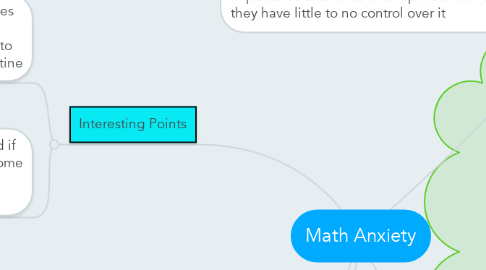
1. Who Struggles?
1.1. Students with a negative attitude toward math
1.2. About 20% of the adult population in the U.S.
1.3. Anxiety increases in adolescents
1.4. Girls
1.4.1. Girls are still exposed to negative stereotypes about their mathematical ability
2. Math content students struggle with
2.1. Mastery of Number Facts
2.2. Computational Weakness
2.3. Difficulty Transferring Knowledge
2.4. Making Connections between Concepts
2.5. Incomplete Understanding of the Language of Math
2.6. Difficulty Comprehending the Visual and Spatial Aspects and Perceptual Difficulties
3. Anxiety is experienced when students see the importance and value of a topic but feel that they have little to no control over it
4. Interesting Points
4.1. Anxiety compromises a student's thinking skills and resources such as working memory, which makes mental calculations difficult to do. Mental math work should be incorporated into student work daily so that it becomes apart of students' routine
4.2. Society has placed importance on being 'math smart' and if students don't feel that they are good at math it has become acceptable to have anxiety and want to 'run away' from math.
4.2.1. Students need to see that math is all around them and that everyone is capable of doing mathematics, we just work and think differently
4.2.2. If a student is good at math and openly admits it they are often labelled as a 'nerd'. Often this leads to adolescent students becoming self-conscious and they can begin to shy away from the subject.
5. What teachers can do
5.1. Eliminate stigma
5.1.1. Show empathy
5.2. Discuss strengths
5.2.1. Point out the areas where the student succeeds
5.3. Discuss areas of weakness
5.3.1. Remind the student that everyone has different strengths and weaknesses
5.4. Be optimistic
5.4.1. Let students know that failures are ok
5.4.2. Students may have to work harder in some subjects than in others
5.4.3. Encourage a growth mindset
5.5. Teach children problem solving strategies
5.5.1. Teach students what to do when they hit a road block. Have them determine what the question is asking them. What do they know? What are they unsure about?
5.6. Identify an ally
5.6.1. This could be a family member, a peer or another teacher. This person should help provide the student with support
5.7. Protect students from humiliation
5.7.1. When students feel ashamed they will not be learning
5.8. Engage students
5.8.1. Use questions that interest students and provide practical skills to real-life problems.
